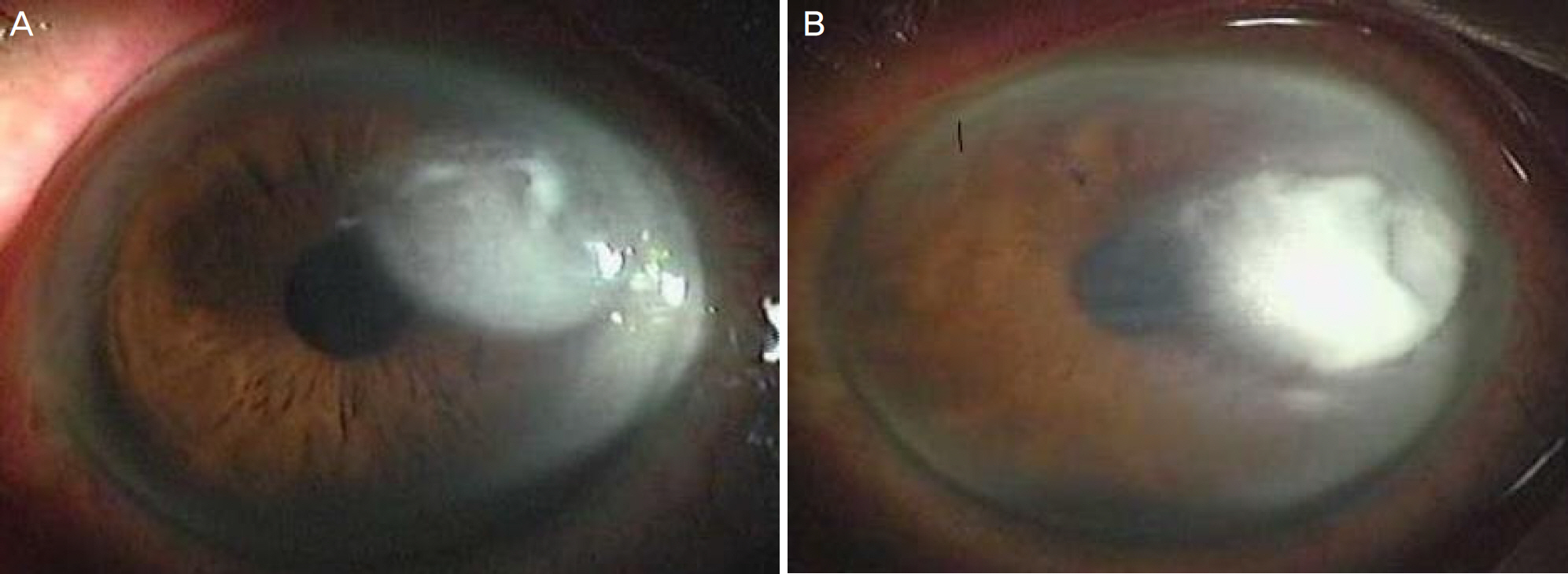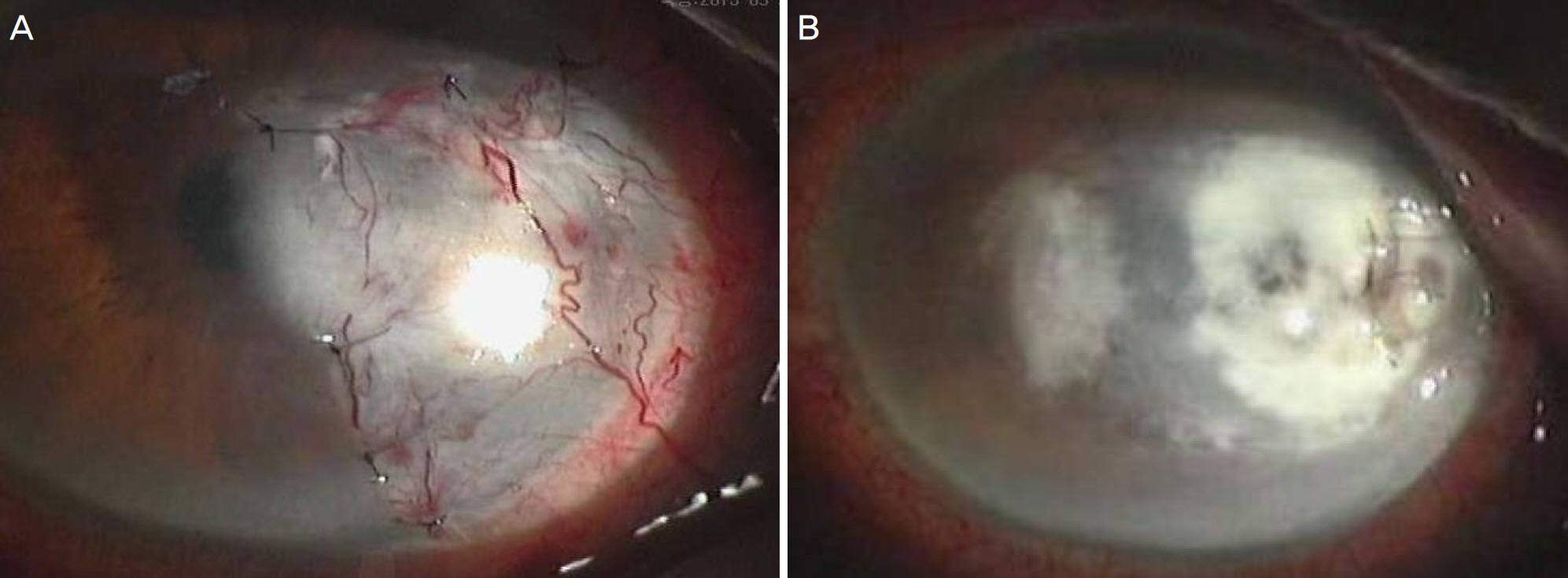J Korean Ophthalmol Soc.
2016 Nov;57(11):1795-1800. 10.3341/jkos.2016.57.11.1795.
Keratitis Caused by Paecilomyces lilacinus after Cataract Surgery in a Patient with Systemic and Autoimmune Disease
- Affiliations
-
- 1Department of Ophthalmology, Samsung Changwon Hospital, Sungkyunkwan University School of Medicine, Changwon, Korea.
- 2Department of Laboratory Medicine, Maryknoll Medical Center, Busan, Korea.
- 3Department of Ophthalmology, Ulsan University Hospital, University of Ulsan College of Medicine, Ulsan, Korea. coolleo@uuh.ulsan.kr
- KMID: 2357739
- DOI: http://doi.org/10.3341/jkos.2016.57.11.1795
Abstract
- PURPOSE
To report a case of Paecilomyces lilacinus fungal keratitis after cataract surgery in a patient with chronic systemic and autoimmune disease who was treated with medical therapy and penetrating keratoplasty.
CASE SUMMARY
A 72-year-old female was referred for decreased visual acuity and ocular pain in the left eye. She underwent cataract surgery in the left eye 1 month earlier and was treated for 2 weeks for corneal edema and stromal infiltration around the corneal suture. She had a chronic systemic disease with hypertension, hyperlipidemia, hepatitis C and rheumatoid arthritis. Suspecting infectious keratitis, the patient was instructed to stop applying topical and systemic steroids and use topical amphotericin B (0.15%) and moxifloxacin (0.5%). However, without improvement, amphotericin B (0.15%) and moxifloxacin (0.5%) were changed to natamycin (5%) and topical voriconazole (2%) and systemic voriconazole was added. However, her systemic status deteriorated and corneal melting developed, scleral graft implantation and amniotic membrane implantation were performed to prevent corneal perforation 6 weeks after the initial visit. Paecilomyces lilacinus was identified in culture at 7 weeks and penetrating keratoplasty was performed 12 weeks after the initial visit. After penetrating keratoplasty, corneal status was stable for 6 months and no signs of recurrence were observed.
CONCLUSIONS
In a patient with Paecilomyces lilacinus fungal keratitis and chronic systemic and autoimmune disease, penetrating keratoplasty showed good prognosis when the disease was refractory to topical and systemic antifungal agents.
MeSH Terms
-
Aged
Amnion
Amphotericin B
Antifungal Agents
Arthritis, Rheumatoid
Autoimmune Diseases*
Cataract*
Corneal Edema
Corneal Perforation
Female
Freezing
Hepatitis C
Humans
Hyperlipidemias
Hypertension
Keratitis*
Keratoplasty, Penetrating
Natamycin
Paecilomyces*
Prognosis
Recurrence
Steroids
Sutures
Transplants
Visual Acuity
Voriconazole
Amphotericin B
Antifungal Agents
Natamycin
Steroids
Voriconazole
Figure
Reference
-
References
1. Srinivasan M. Fungal keratitis. Curr Opin Ophthalmol. 2004; 15:321–7.
Article2. Abad JC, Foster CS. Fungal keratitis. Int Ophthalmol Clin. 1996; 36:1–15.
Article3. Malecha MA, Tarigopula S, Malecha MJ. Successful treatment of Paecilomyces lilacinus keratitis in a patient with a history of herpes simplex virus keratitis. Cornea. 2006; 25:1240–2.
Article4. Jacobs H, Gray SN, Crump DH. Interactions between nem-atophagous fungi and consequences for their potential as abdominal agents for the control of potato cystnematodes. Mycol Res. 2003; 107(Pt 1):47–56.5. Okhravi N, Dart JK, Towler HM, Lightman S. Paecilomyces abdominal endophthalmitis with secondary keratitis: a case report and abdominal review. Arch Ophthalmol. 1997; 115:1320–4.6. Chander J, Sharama A. Prevalence of fungal corneal ulcers in northern India. Infection. 1994; 22:207–9.
Article7. Tanure MA, Cohen EJ, Sudesh S, et al. Spectrum of fungal keratitis at Wills Eye Hospital, Philadelphia, Pennsylvania. Cornea. 2000; 19:307–12.
Article8. Hahn YH, Lee DJ, Kim MS, et al. Epidemiology of fungal keratitis in Korea: a Multi-center Study. J Korean Ophthalmol Soc. 2000; 41:1449–508.9. Roumpos C. Ecological studies on Paecilomyces lilacinus strain 251 and their importance for biocontrol of plant-parasitic nemat-odes and environmental risk assessment. 1st ed.Göttingen: Cuvillier Verlag;2005. p. 16–39.10. Hirst LW, Sebban A, Whitby RM, et al. Non-traumatic mycotic keratitis. Eye (Lond). 1992; 6(Pt 4):391–5.
Article11. Pastor FJ, Guarro J. Clinical manifestations, treatment and abdominals of Paecilomyces lilacinus infections. Clin Microbiol Infect. 2006; 12:948–60.12. Yuan X, Wilhelmus KR, Matoba AY, et al. Pathogenesis and abdominal of Paecilomyces keratitis. Am J Ophthalmol. 2009; 147:691–6.13. Wu PC, Lai CH, Tan HY, et al. The successful medical treatment of a case of Paecilomyces lilacinus keratitis. Cornea. 2010; 29:357–8.
Article14. Monden Y, Sugita M, Yamakawa R, Nishimura K. Clinical abdominal treating Paecilomycs lilacinus keratitis in four patients. Clin Ophthalmol. 2012; 6:949–53.15. McLintock CA, Lee GA, Atkinson G. Management of recurrent Paecilomyces lilacinus keratitis. Clin Exp Optom. 2013; 96:343–5.
Article16. Won JY, Shin JY, Hwang JH, Joo CK. A case of fungal keratitis caused by Paecilomyces lilacinus after penerating keratoplasty. J Korean Ophthalmol Soc. 2014; 55:1384–7.17. Bunya VY, Hammersmith KM, Rapuano CJ, et al. Topical and oral voriconazole in the treatment of fungal keratitis. Am J Ophthalmol. 2007; 143:151–3.
Article18. Byun DS, Yang HN, Cho HG, Cha YJ. A case of corneal ulcer caused by Paecilomyces in diabetic patient wearing soft contact lens. J Korean Ophthalmol Soc. 1987; 28:667–71.19. Chung SR, You IC, Cho NC, Ahn M. Paecilomyces keratitis: cases in Korea and literature review. J Korean Ophthalmol Soc. 2016; 57:390–8.
Article20. Henry CR, Flynn HW Jr, Miller D, et al. Delayed-onset endophthalmitis associated with corneal suture infections. J Ophthalmic Inflamm Infect. 2013; 3:51.
Article
- Full Text Links
- Actions
-
Cited
- CITED
-
- Close
- Share
- Similar articles
-
- A Case of Fungal Keratitis Caused by Paecilomyces lilacinus after Penetrating Keratoplasty
- A Localized Cutaneous Paecilomyces lilacinus Infection Treated with Voriconazole
- A Case of Localized Skin Infection Due to Paecilomyces lilacinus
- Paecilomyces Keratitis: Cases in Korea and Literature Review
- Cutaneous Abscess Caused by Paecilomyces lilacinus in a Renal Transplant Patient





